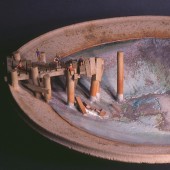![]() Printer version
Printer version
Raymon Elozua
1947Born Bernstadt, West Germany
EDUCATION
1965-1969Political Science, Sculpture and Theatre, University of Chicago, Chicago, Illinois
PRIMARY WORK EXPERIENCE
1979-1999Consultant and Curator, The Allan Chasanoff and Raymon Elozua Amazing Grace Collection, Smithsonian Institution, Washington, D.C.
1982-1986Faculty, Ceramic Sculpture, New York University, New York, New York
1984-1985Faculty, Graduate Department, Pratt Institute School of Art and Design, Brooklyn, New York
BIOGRAPHY
Raymon Elozua’s clay career began with functional pots but quickly moved to create post-industrialist ceramic sculptures incorporating metal and clay components. Following trends in photo-realism, he modeled sculptures of deteriorating American industrial architecture including, water towers, industrial sites, billboards, and drive-in movie theatres.
Elozua used these sculptures as a way to comment on the socio-economic consequences of industrial decline and its effect on American blue collar workers of the 1980s. Using a combination of open metal forms and colorfully glazed components, Elozua created a series of deconstructed teapots, bottles and traditional pottery forms.
In the 1990s Elozua used a computer to scan iconic paintings and separate their colors into individual layers. He then created a collage from selected layers of scans from different paintings. Each collage was then studied, interpreted and sculpted into a wire and clay mixed media sculpture. These works were titled to reference the artists whose work was used in layers of the original collages.
During his career, Elozua produced a large body of photographic images of weathering objects and buildings. With Allan Chasanoff, Elozua created the Amazing Grace Collection of 3,000 recorded performances of "Amazing Grace," now held by The Library of Congress, Washington, D.C.
A digital exhibition of Elozua's work, first shown May 10 - August 3, 2003, at the Mint Museum of Craft + Design, is available at http://www.mintmuseum.org/elozua/.
PUBLIC COLLECTIONS
Albany Museum of Art, Albany, Georgia
Alfred Ceramic Art Museum, Alfred University, Alfred, New York
Arizona State University Art Museum, Tempe, Arizona
Belger Arts Center, Kansas City, Missouri
Birmingham Museum of Art, Birmingham, Alabama
Carnegie Museum of Art, Pittsburgh, Pennsylvania
Contemporary Art Museum, Honolulu, Hawaii
Cranbrook Art Museum, Cranbrook Academy of Art, Bloomfield Hills, Michigan
Crocker Art Museum, Sacramento, California
Daum Museum of Contemporary Art, Sedalia, Missouri
De Saisset Museum, University of Santa Clara, California
Erie Art Museum, Erie, Pennsylvania
Everson Museum of Art, Syracuse, New York
Frederick R. Weisman Museum, University of Minnesota, Minneapolis, Minnesota
Long Beach Museum of Art, Long Beach, California
Los Angeles County Museum of Art (LACMA), Los Angeles, California
Mint Museum, Charlotte, North Carolina
Montclair Art Museum, Montclair, New Jersey
Museum of Fine Arts, Houston, Texas
Museum Ludwig, Aachen, Germany
Museum of Arts and Design, New York, New York
Nora Eccles Harrison Museum, Logan State University, Logan, Utah
Newark Museum, Newark, New Jersey
Ohio Historical Society, Youngstown, Ohio
Oakland Museum of California, Oakland, California
San Angelo Museum of Fine Arts, San Angelo, Texas
San Francisco Museum of Modern Art, San Francisco, California
Wadsworth Atheneum, Hartford, Connecticut
World Ceramic Foundation, Korea
Wison Art Museum, Shanghai, China
BIBLIOGRAPHY
Del Vecchio, Mark. Postmodern Ceramics. New York: Thames & Hudson, Inc., 2001.
Dietz, Ulysses Grant. Great Pots Contemporary Ceramics from Function to Fantasy. Madison, WI: Guild Publishing, 2003.
Lauria, Jo. Color and Fire Defining Moments in Studio Ceramic. Los Angeles, CA: Los Angeles County Museum of Art and Rizzoli International Publications, 1950-2000.
CV or RESUME: Click Here to Download
WEBSITE(S):
Artist's Studio: Elozua Studios
Citation: "The Marks Project." Last modified August 23, 2025. http://www.themarksproject.org:443/marks/elozua













